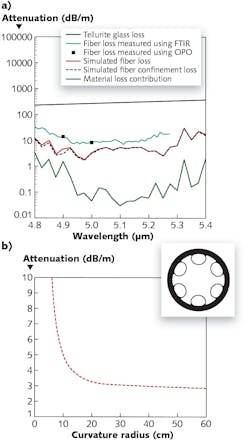Tellurite hollow-core antiresonant fiber for mid-IR is quite bendable

High-power mid-infrared (mid-IR) lasers are used for laser surgery, as well as in some types of materials processing—both of which require that the optical power be easily, precisely, and safely moved to the right spot, wherever that may be. Delivering light via optical fiber is a leading approach, with one large drawback of the conventional solid-core chalcogenide glass fibers being absorption of the mid-IR light and the resulting fiber heating and damage. Hollow-core microstructured fibers greatly reduce light absorption due to the air core. Numerous designs, including those of hollow-core antiresonant fibers (HC-ARFs), are being developed; these fibers simultaneously have a large core size and effectively single-mode guidance.
However, HC-ARFs, which usually consist of delicate, air-filled structures within a solid cladding, are difficult to fabricate—in addition, the chalcogenide glass they are often made from can be somewhat toxic. A group of researchers from the Optoelectronics Research Centre, University of Southampton (England) and the Center of Materials and Nanotechnologies, University of Pardubice (Czech Republic) is experimenting with tellurite glass as a material from mid-IR HC-ARFs, and has designed and fabricated tellurite HC-ARFs that have optical losses of only 8.2 ±0.6 dB/m, 4.8 ±0.4 dB/m, and 6.4 ±0.4 dB/m at mid-IR wavelengths of 5, 5.6, and 5.8 μm, respectively. Light was transmitted through a 13-cm-long test sample with near-single-mode quality (M2 factor of 1.2). The fiber preforms are coated with fluorinated ethylene propylene (FEP) polymer such that, when drawn, the finished fibers have an FEP coating that increases durability and protects the fibers from moisture.
The researchers chose a tellurite glass formulation (70TeO2-13ZnO-10BaO-7K2O) with a cutoff wavelength of 6.1 µm; they note that fluoride glasses, another mid-IR material candidate, have much lower thermal stability than tellurite glasses. And unlike chalcogenide and fluorite glasses, tellurite glasses can be synthesized in an ambient air environment (in contrast to needing a protective atmosphere). Both these factors, along with nontoxicity, made it straightforward for the researchers to synthesize the glass in-house, which they did by melting the precursors in a gold crucible at 800°C for 2 hours.
Attenuation measured via FTIR and OPO
Two experimental specimens were made—fibers A and B, both 9 m long, fabricated with 6 and 5.2 mbar of pressure into the fiber’s capillaries during fiber drawing, respectively. The transmission loss of a 36 cm length of fiber A was measured using a Fourier-transform IR (FTIR) spectrometer, with light from a Thorlabs SLS202L stabilized tungsten lamp as the source; minimum measured loss was at a 5.1 μm wavelength (see figure). The results were checked by measuring transmission using an optical parametric oscillator (OPO) at 4.9 and 5 μm as the source; results of the two different approaches matched well. Fiber B was measured using the OPO as a source. In addition, the experimental losses were compared to simulations using COMSOL multiphysics, in which the experimental fiber cross-sections were measured and entered into the simulation software (using the real part of the tellurite glass refractive index).
In another test, Fiber B was subjected to bending at various curvatures from 60 to about 7 cm, with loss doubling at a 9 cm radius. However, the fiber can be bent to a radius of only 4 cm without breaking. The researchers expect that the measured mode quality of M2 = 1.2 for a 13 cm fiber will improve (get closer to 1) as longer lengths of fiber are used, due to the preferential absorption of higher modes. They also note that simulations show that, with improved fabrication techniques, the fiber loss could be lowered to less than 0.1 dB/m in the mid-IR.
REFERENCE
1. A. Ventura et al., Opt. Express (2020); https://doi.org/10.1364/oe.390517.
About the Author
John Wallace
Senior Technical Editor (1998-2022)
John Wallace was with Laser Focus World for nearly 25 years, retiring in late June 2022. He obtained a bachelor's degree in mechanical engineering and physics at Rutgers University and a master's in optical engineering at the University of Rochester. Before becoming an editor, John worked as an engineer at RCA, Exxon, Eastman Kodak, and GCA Corporation.
